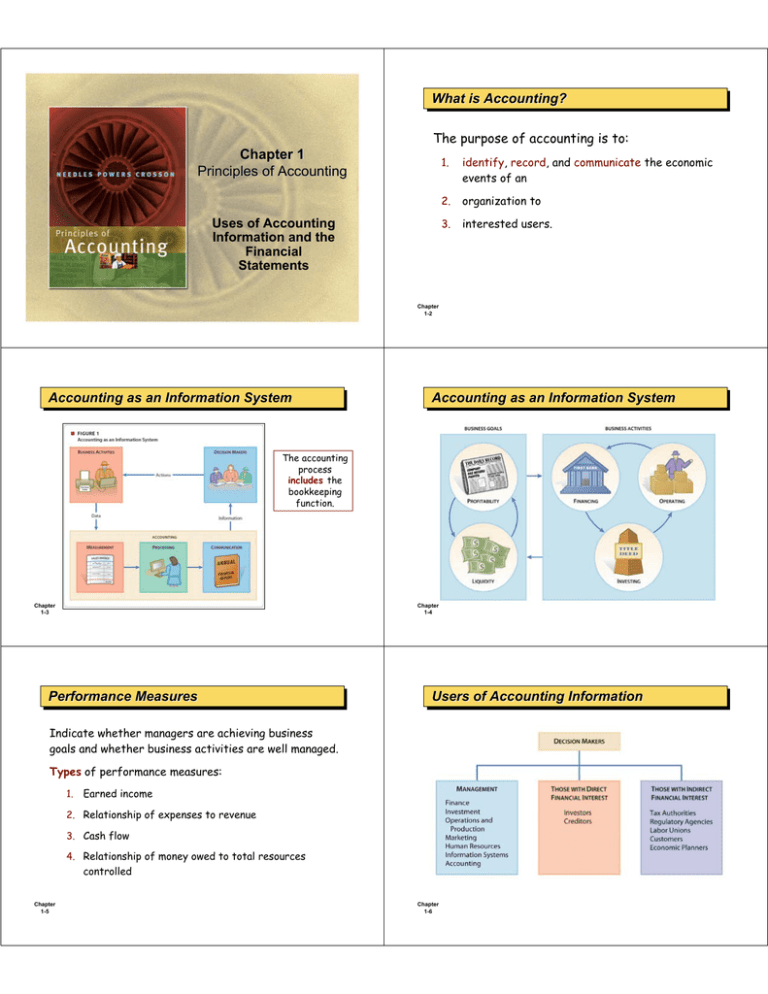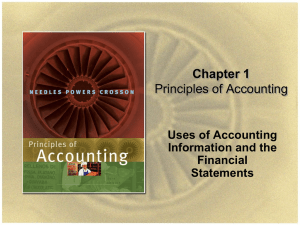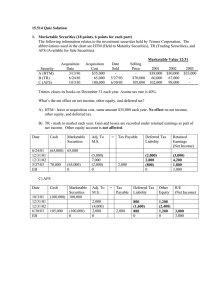
What
What is
is Accounting?
Accounting?
The purpose of accounting is to:
Chapter 1
Principles of Accounting
Uses of Accounting
Information and the
Financial
Statements
Chapter
1-1
1.
identify, record, and communicate the economic
events of an
2.
organization to
3.
interested users.
Chapter
1-2
Accounting
Accounting as
as an
an Information
Information System
System
Accounting
Accounting as
as an
an Information
Information System
System
The accounting
process
includes the
bookkeeping
function.
Chapter
1-3
Chapter
1-4
Performance
Performance Measures
Measures
Users
Users of
of Accounting
Accounting Information
Information
Indicate whether managers are achieving business
goals and whether business activities are well managed.
Types of performance measures:
1.
Earned income
2. Relationship of expenses to revenue
3. Cash flow
4. Relationship of money owed to total resources
controlled
Chapter
1-5
Chapter
1-6
Accounting
Accounting and
and Capital
Capital Allocation
Allocation
Resources are limited. Efficient use of resources often
determines whether a business thrives.
Capital Allocation Process
Financial
Reporting
Information to help
users with capital
allocation decisions.
Chapter
1-7
Users
Investors, creditors,
and other users
Capital
Allocation
The process of
determining how
and at what cost
money is allocated
among competing
interests.
LO 2 Explain how accounting assists in the efficient use of scare
scare resources.
Chapter
1-8
Financial
Financial and
and Management
Management Accounting
Accounting
Uses
Uses of
of Financial
Financial Information
Information
Accounting’s role is divided into two categories:
Ethics In Financial Reporting
1.
Management accounting
2. Financial accounting
Standards of conduct by which one’s actions are
judged as right or wrong, honest or dishonest, fair or
not fair, are Ethics.
Functions overlap.
Recent financial scandals include: Enron, WorldCom,
HealthSouth, AIG, and others.
Primary difference is the principal users of the
information.
Congress passed Sarbanes-Oxley Act of 2002.
Effective financial reporting depends on sound
ethical behavior.
Chapter
1-9
Uses
Uses of
of Financial
Financial Information
Information
Chapter
1-10
Users
Users and
and Uses
Uses of
of Financial
Financial Information
Information
Review Question
Ethics are the standards of conduct by which one's
actions are judged as:
a. right or wrong.
b. honest or dishonest.
c. fair or not fair.
d. all of these options.
Chapter
1-11
Chapter
1-12
SO 2 Identify the users and uses of accounting information.
Accounting
Accounting Measurement
Measurement
Business
Business Transaction
Transaction
Four basic questions:
Economic events that affect the financial position of a
business entity.
1.
What is measured?
1.
2. When should the measurement be made?
An exchange of value between two or more parties.
¾ Purchase, sale, payment, collection, etc.
3. What value should be placed on what is measured?
2. A Nonexchange transaction.
4. How should what is measured be classified?
¾ Loss from fire, flood, theft.
¾ Physical wear and tear on equipment.
¾ Accumulation of interest.
Chapter
1-13
Chapter
1-14
Forms
Forms of
of Business
Business Organization
Organization
Proprietorship
Financial
Financial Position
Position and
and Accounting
Accounting Equation
Equation
Partnership
Corporation
Generally owned
by one person.
Owned by two or
more persons.
Often small
service-type
businesses
Often retail and
service-type
businesses
Ownership
divided into
shares of stock
Owner receives
any profits,
suffers any
losses, and is
personally liable
for all debts.
Generally
unlimited
personal liability
Separate legal
entity organized
under state
corporation law
Limited liability
Partnership
agreement
Chapter
1-15
SO 5 Explain the monetary unit assumption
and the economic entity assumption.
Financial
Financial Statements
Statements
Chapter
1-16
Financial
Financial Statements
Statements
Companies
Companies prepare
prepare four
four financial
financial statements
statements from
from
the
the summarized
summarized accounting
accounting data:
data:
Review Question
Net income will result during a time period when:
a. assets exceed liabilities.
Balance
Sheet
Chapter
1-17
Income
Statement
Retained
Earnings
Statement
b. assets exceed revenues.
Statement
of Cash
Flows
c. expenses exceed revenues.
d. revenues exceed expenses.
Chapter
1-18
Financial
Financial Statements
Statements
Financial
Financial Statements
Statements
Balance Sheet
Balance Sheet
Reports the assets,
liabilities, and
stockholder’s equity at a
specific date.
Retained Earnings
Statement
Assets listed at the top,
followed by liabilities and
stockholder’s equity.
Total assets must equal
total liabilities and
stockholder’s equity.
Chapter
1-19
The ending balance in retained
earnings is needed in
preparing the balance sheet
Chapter
1-20
Financial
Financial Statements
Statements
Financial
Financial Statements
Statements
Retained Earnings
Statement
Income Statement
Statement indicates the
reasons why retained
earnings has increased
or decreased during the
period.
Reports revenues and
expenses for a specific
period of time.
Net income – revenues
exceed expenses.
Net loss – expenses
exceed revenues.
Chapter
1-21
Chapter
1-22
Financial
Financial Statements
Statements
Income Statement
Financial
Financial Statements
Statements
Retained Earnings
Statement
Statement of Cash Flows
Answers:
1. Where did cash come
from during the
period?
2. How was cash used
during the period?
3. What was the change
in the cash balance
during the period?
Net income is needed to
determine the ending balance in
stockholder’s equity.
Chapter
1-23
Chapter
1-24
Financial
Financial Statements
Statements
Review Question
Which of the following financial statements is
prepared as of a specific date?
Other
Other Elements
Elements of
of an
an Annual
Annual Report
Report
U.S. companies that are publicly traded must provide
shareholders with an annual report.
The annual report always includes:
a. Balance sheet.
Financial statements.
b. Income statement.
Management discussion and analysis.
c. Owner's equity statement.
Notes to the financial statements.
d. Statement of cash flows.
Chapter
1-25
Independent auditor's report.
Chapter
1-26
Other
Other Elements
Elements of
of an
an Annual
Annual Report
Report
Generally
Generally Accepted
Accepted Accounting
Accounting Principles
Principles
Auditor’s Report
Various users
need financial
information
Standard unqualified opinion – auditor expresses the
opinion that the financial statements are presented
fairly, in all material respects, in conformity with GAAP.
Financial Statements
Balance
Balance Sheet
Sheet
Income
Income Statement
Statement
Statement
Statement of
of Stockholders’
Stockholders’ Equity
Equity
Statement
Statement of
of Cash
Cash Flows
Flows
Note
Note Disclosure
Disclosure
The accounting profession
has attempted to develop a
set of standards that are
generally accepted and
universally practiced.
Chapter
1-27
Generally Accepted
Accounting Principles
(GAAP)
Chapter
1-28
Generally
Generally Accepted
Accepted Accounting
Accounting Principles
Principles
Standard Setting in a Political Environment
Accounting standards are as much a product of
political action as they are of careful logic or
empirical findings.
Standard
Standard Setting
Setting
Business
BusinessEntities
Entities
CPAs
CPAsand
and
Accounting
AccountingFirms
Firms
AICPA
AICPA(AcSEC)
(AcSEC)
Financial
Financial
Community
Community
FASB
FASB
(e.g.,
(e.g.,FEI)
FEI)
(SEC,
(SEC,IRS,
IRS,other
other
agencies)
agencies)
Investing
InvestingPublic
Public
Accounting standards,
interpretations, and bulletins
Chapter
1-30
Preparers
Preparers
Government
Government
Academicians
Academicians
Chapter
1-29
User Groups that Influence
Accounting Standards
Industry
Industry
Associations
Associations
Generally
Generally Accepted
Accepted Accounting
Accounting Principles
Principles
Securities
Securities and
and Exchange
Exchange Commission
Commission
Organizations:
Established by federal government
Accounting and reporting for public companies
¾ Securities and Exchange Commission (SEC).
¾ Financial Accounting Standards Board (FASB).
Securities
Securities Act
Act
of
of 1933
1933
¾ Public Company Accounting Oversight Board (PCAOB).
Securities
Securities Act
Act
of
of 1934
1934
¾ American Institute of Certified Public Accountants
(AICPA).
Encouraged private standard-setting body
¾ International Accounting Standards Board (IASB).
SEC requires public companies to adhere to GAAP
SEC Oversight
Enforcement Authority
Chapter
1-31
Chapter
1-32
Issues
Issues in
in Financial
Financial Reporting
Reporting
Copyright
Copyright
International Accounting Standards
“Copyright © 2009 John Wiley & Sons, Inc. All rights reserved.
Reproduction or translation of this work beyond that permitted
in Section 117 of the 1976 United States Copyright Act without
the express written permission of the copyright owner is
unlawful. Request for further information should be addressed
to the Permissions Department, John Wiley & Sons, Inc. The
purchaser may make back-up copies for his/her own use only
and not for distribution or resale. The Publisher assumes no
responsibility for errors, omissions, or damages, caused by the
use of these programs or from the use of the information
contained herein.”
Two sets of standards accepted for international use:
U.S. GAAP, issued by the FASB
International Financial Reporting Standards
(IFRS), issued by the IASB
FASB and IASB recognize that
global markets will best be
served if only one set of GAAP
is used.
Chapter
1-33
Chapter
1-34







